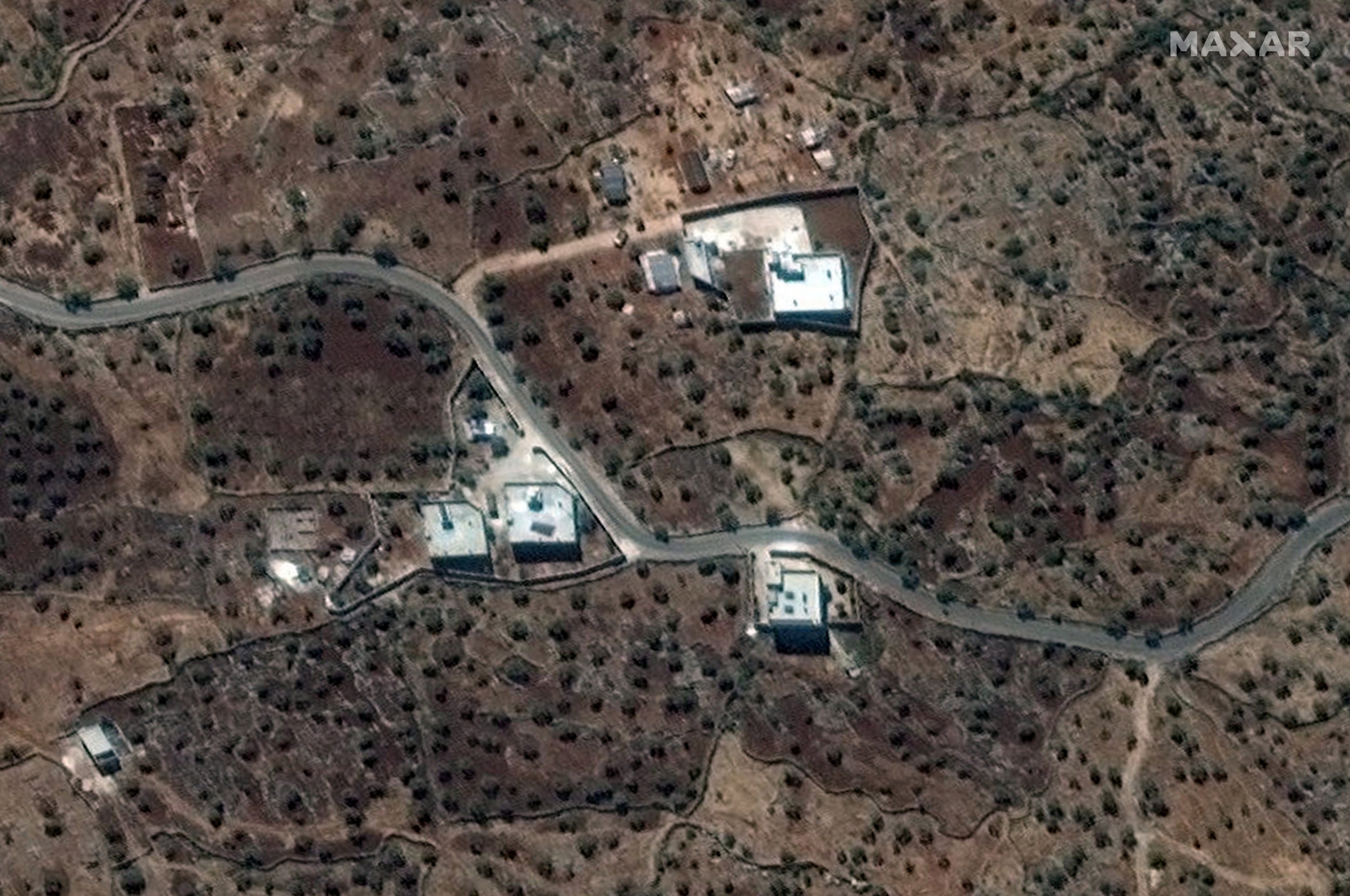Your support helps us to tell the story
From reproductive rights to climate change to Big Tech, The Independent is on the ground when the story is developing. Whether it's investigating the financials of Elon Musk's pro-Trump PAC or producing our latest documentary, 'The A Word', which shines a light on the American women fighting for reproductive rights, we know how important it is to parse out the facts from the messaging.
At such a critical moment in US history, we need reporters on the ground. Your donation allows us to keep sending journalists to speak to both sides of the story.
The Independent is trusted by Americans across the entire political spectrum. And unlike many other quality news outlets, we choose not to lock Americans out of our reporting and analysis with paywalls. We believe quality journalism should be available to everyone, paid for by those who can afford it.
Your support makes all the difference.Abu Bakr al-Baghdadi, the world’s most wanted man, may have chosen an unlikely hiding spot within enemy territory in northwest Syria because he was trying to organise the smuggling of family members across the Turkey border.
It seemed unthinkable that the brutal Isis leader, a veteran escape artist, would take cover in Idlib, a province controlled by Hayat Tahrir al-Sham (HTS), an al-Qaeda affiliate and sworn enemy of his own group.
But in the early hours of Sunday morning, he ignited a suicide vest during a dramatic US raid on a secluded compound southwest of the sleepy village of Barisha, a 15-minute drive from the border.
The 48-year-old, who had spent just over five days at this two-storey building complex, complete with an underground basement or tunnels, according to Iraqi intelligence officials who helped reveal his location to the Americans.
It was owned by a shadowy figure known locally as "Abu Mohamed al-Halabi" because he is from "Halab" or Aleppo in English, although his real surname is Salama.
Halabi’s neighbours thought he was nothing more than a food trader or merchant, who kept “himself to himself”, had no visitors and drove a blue Hyundai. A white van was sometimes spotted shuttling to and from the house with supplies.
HTS fighters, who were stunned to learn Baghdadi had been nearby, said Halabi was part of Hurras al-Din, a comparatively new jihadi offshoot whose relations with Isis, though not as acrimonious as HTS, were still not friendly.
According to Iraqi intelligence however, Halabi was also a known border smuggler and that network led them and the Americans straight to him.
“We know Baghdadi was in the house for five days prior to the raid, but in Idlib a few months longer than that,” one Iraqi intelligence official told The Independent. “We believe he had tried to smuggle his family and that is why he was exposed.”
Hisham Hashimi, a Baghdad-based expert on Isis, agreed.
“That’s exactly why he was there,” he told The Independent.
He added: “Hurras Al-Din, especially Abu Mohamed al-Halabi, are nothing more to Baghdadi than a smuggling ring to help the leaders’ families escape to Turkey.”
Dragging three of his children with him, Baghdadi, blew himself up when US troops and dogs cornered him in a dead-end tunnel.
Later Donald Trump would describe the raid in vivid detail saying US Delta Forces blasted through the compound walls and chased down the jihadi leader while he was “crying, screaming and whimpering”.
But at that moment few knew what was going on.
It was 11.30pm local time when eight helicopters and drones first entered the area, after a 70-minute flight from Erbil that crisscrossed into and out of Syria.
The airdrop began around 45 minutes later.
Neighbours living in one tent which was just a few metres away from Halabi's compound described how foreign soldiers with machine guns suddenly appeared from helicopters telling them in Arabic they had to leave.
On the other side of the usually sleepy village, other local residents described the sudden explosion of heavy machine gunfire, they would later see the sky light up as the compound was pounded with multiple airstrikes.
In total around 30 US soldiers dropped to the ground and scattered, with some sent to keep back civilians living nearby.
Overhead on a microphone, a voice in perfect Arabic ordered Halabi to come out with his guests.
When there was no response, the soldiers blasted their way through the eastern wall of the compound and fierce clashes erupted.
In the middle of the melee, a roaming HTS force patrol confused at the sudden arrival of so many aircraft in a usually quiet area mistook it for a Syrian regime attack. They fired anti-aircraft guns at the US helicopters, who fired back killing the patrol.
Amid the fighting two children, rescued from the compound were bought by a soldier and handed them to a civilian shepherd.
Baghdadi at some point over the next hour blew himself up. Trump said he ran into a tunnel, local sources described it more like a basement, where the feared Isis chief and his family had been living.
Several of the people thought to be in the house at the time, were also killed including two of Baghdadi's wives. Al-Halabi is currently missing believed dead.
Some of Baghdadi's aides are also unaccounted for, including a close confidante who escorted him everywhere.
After confirming the Baghdadi's ID through DNA testing on-site, soldiers removed bodies and body parts and left.
US aircraft then completely flattened the four-room house and compound. The job was done.
Hours later, Isis would receive yet another blow. In the neighbouring province of Aleppo, a key spokesman and possible successor to Baghdadi also perished.
Kurdish forces and the Syrian Observatory for Human Rights (SOHR) reported that Abu Hassan al-Muhajir was killed late on Sunday near Jarablus, a town about 140km northeast of Barisha.
The Britain-based SOHR said he was travelling in a convoy made up of an oil tanker and a sedan.
The commander of Syria’s Kurdish forces Mazloum Abdi said his group’s intelligence unit carried out a joint operation with US troops.
Back in Idlib growing alarm spread through jihadi WhatsApp groups over what was going on near the border with Turkey.
In one Idlib Operations room group, Hurras al-Din members reported a massive US raid in the area they thought was targeting one of their leaders.
“They said the target was the home of this guy Halabi and he is a senior person in Hurras al-Din,” said Elizabeth Tsurkov, a Syria and Iraq expert at the Foreign Policy Research Institute, an American think tank.
“This large compound was known to be the home of this person. People in the group presented him as being with Hurras al-Din,” she added.
Ms Tsurkov, who follows jihadi groups in Idlib closely, said the notoriously secretive Hurras al-Din, which has just under 2,000 fighters, was struggling financially and had witnessed a drop in numbers as it was struggling to pay salaries.
It even launched a campaign for donations last week.
A financial motive may have connected the dots between the unlikely allies, but it is impossible to say.
We believe he had tried to smuggle his family and that is why was exposed.”
Back in Washington Donald Trump was quick to thank Turkey and Russia, which controls the airspace used to successfully complete the raid, as well as the Iraqi government and the Kurds for their intelligence assistance.
Since then there has been a war of words between the Iraqis and the Kurds over who helped locate Baghdadi first.
Polat Can, a senior advisor to the Kurdish-Led Syrian Democratic Forces, released a flurry of tweets on Monday night, claiming that Kurdish intelligence had been key to finding Baghdadi.
He said an SDF source had even managed to obtain a pair of Baghdadi’s underwear to secure the DNA to identify him and located spokesman Abu Hassan, who was apparently on a special mission to Jarablus to secure Baghdadi’s transfers to his new home.
“Through our own sources, we managed to confirm that Baghdadi had moved from Al Dashisha area in Deir Ezzor to Idlib. Since 15 May, we have been working together with the CIA to track Al Baghdadi and monitor him closely,“ he added.
Iraqi intelligence meanwhile said their information, gathered from a slew of arrests had been vital.
Intelligence sources and Fadel Abo Raghif, an expert in radical movements at the Wasatiyyah Centre think tank, said most of the information came from Baghdadi’s brother-in-law Muhammad Ali Sajid al-Zobaie who was detained last year.
He apparently led them to a desert tunnel near Qaim city in Iraq where they found two hideouts filled with items, including light weapons, religious books, medical items and hand-drawn maps.
Mr Hashimi added that this allowed the operation room to penetrate a smuggling ring Baghdadi was using and to follow him to Idlib at the end of August or September 2019.
No one knows exactly how Baghdadi got to Barisha village but it was a natural choice, no jihadi groups fully control the immediate surroundings which are known to be a "safe zone": an area close to the border and mostly populated by internally displaced people, making it easier to hide.
Iraqi security officers told the Reuters news agency that the arrest of Ismael al-Ethawi, another aide to Baghdadi also helped “complete the missing pieces of the puzzle”, in particular revealing the details of five men Baghdadi was meeting in Syria and the different locations they used.
El-Thawi described how Baghdadi would sometimes hold strategy talks with his commanders in moving minibuses packed with vegetables in order to avoid detection.
US officials also reported that Baghdadi’s remains had been buried at sea from an aircraft in an unknown location. Echoing the anonymous sea burial given to al-Qaeda chief Osama Bin Laden, Baghdadi was afforded proper religious rites according to Islamic custom.
At the same time speculation swirled about whether Isis had appointed a new leader.
The Iraqi intelligence officer, Fadel Abo Raghif and Mr Hashimi all told The Independent the most likely pick was Abdulla Qardash, a former Saddam Hussein-era military officer from Tel Afar near Mosul who like Baghdadi was jailed by the US in Camp Bucca between 2003-2004.
Qardash is apparently already the power behind the throne, while Baghdadi, suffering from diabetes and hypertension, was forced to shuttle around Syria.
The other contenders, which are far less likely as they do not have the tribal pedigree required to be a caliph, are named as Abu Abdulrahman el-Jazrawy, who heads up Isis’s executive body and Abo Othman al-Tunsi who leads Isis’s Shura council.
“It is likely they will issue an obituary first followed by an election in the Shura to select a substitute,” Abu Raghif said.
On some Isis channels, there are furious discussions about what next.
But for now the global feared group has yet to make a formal announcement and the mantle has yet to be passed down.


Join our commenting forum
Join thought-provoking conversations, follow other Independent readers and see their replies
Comments